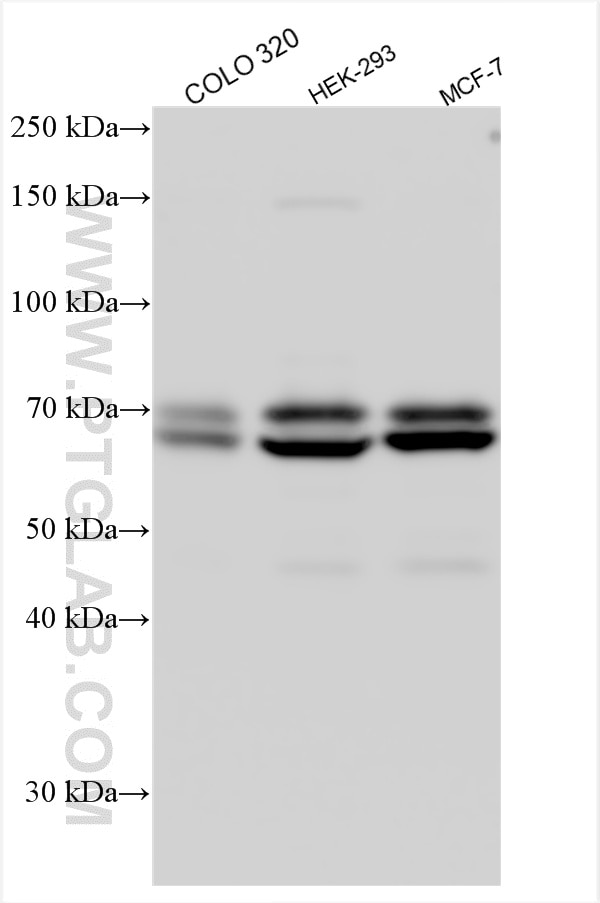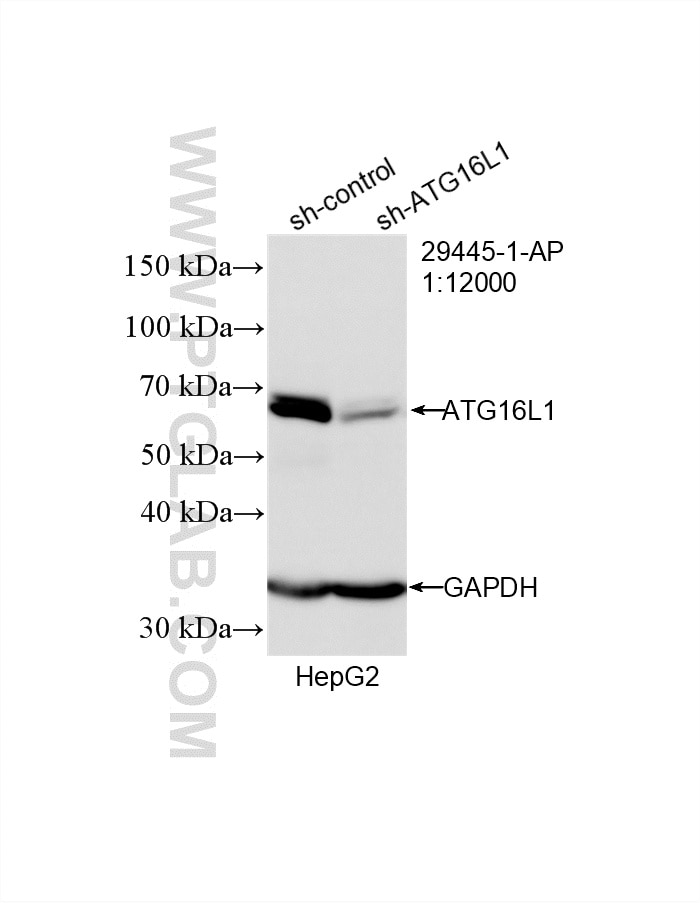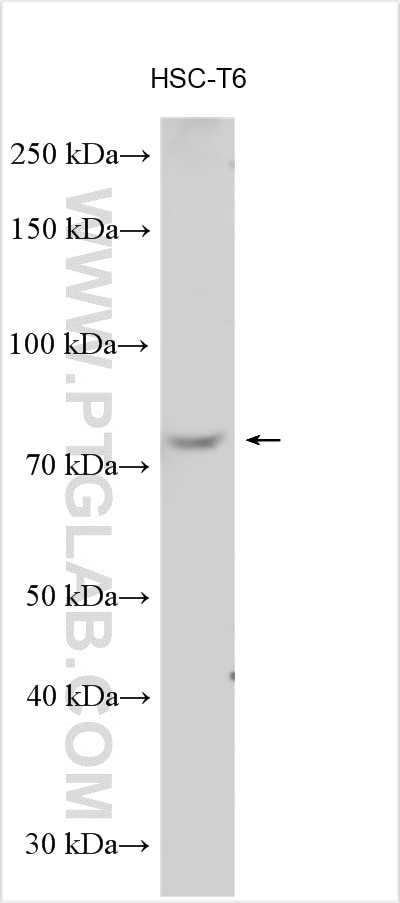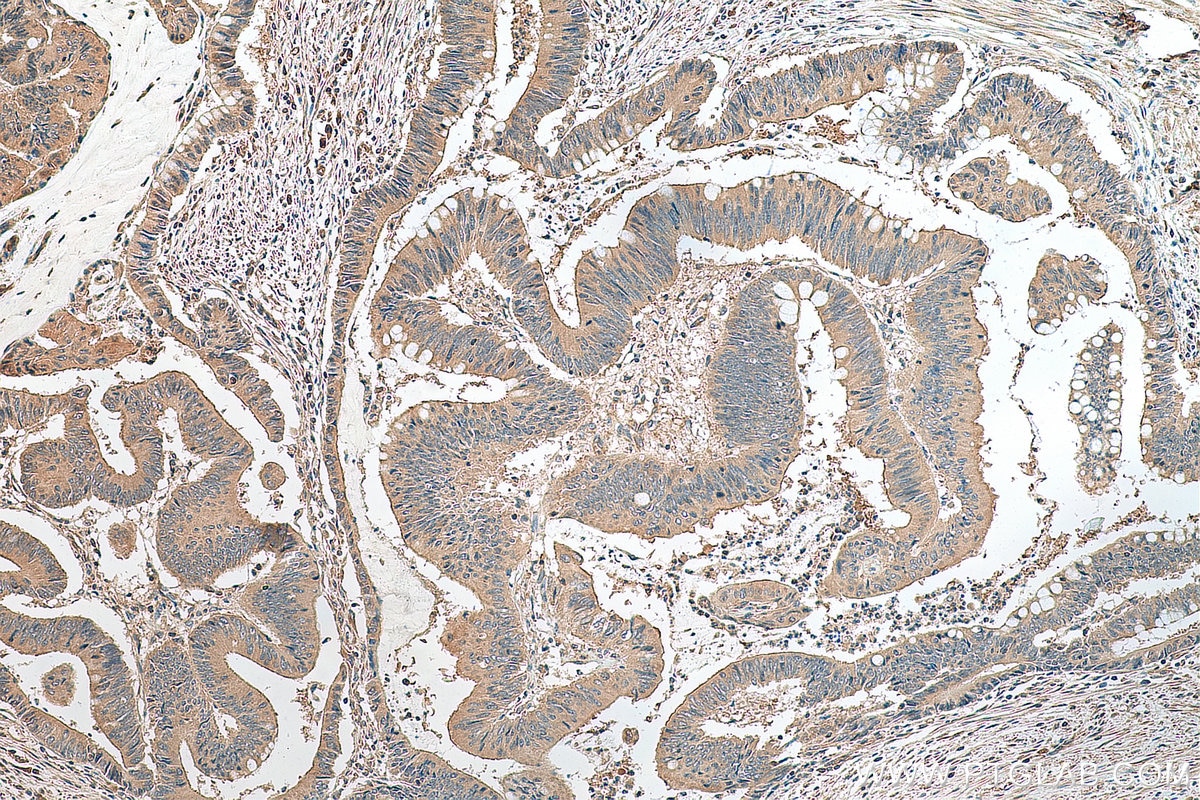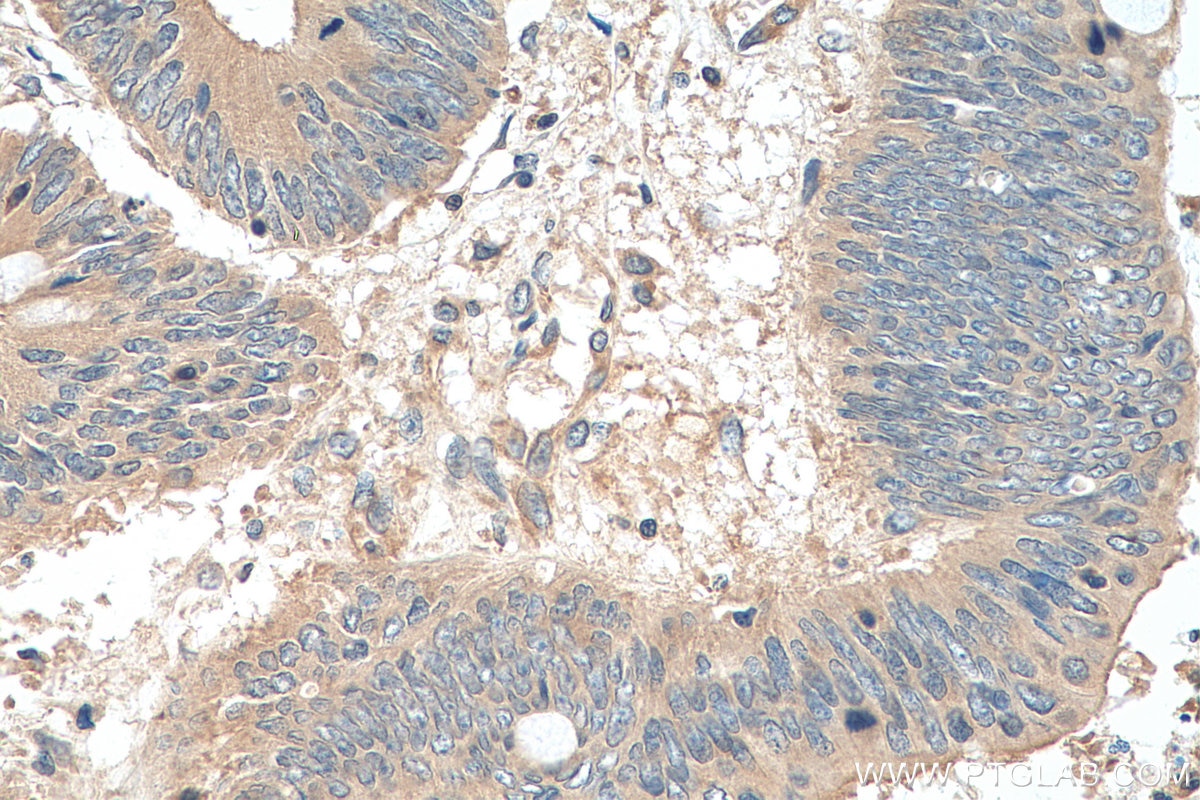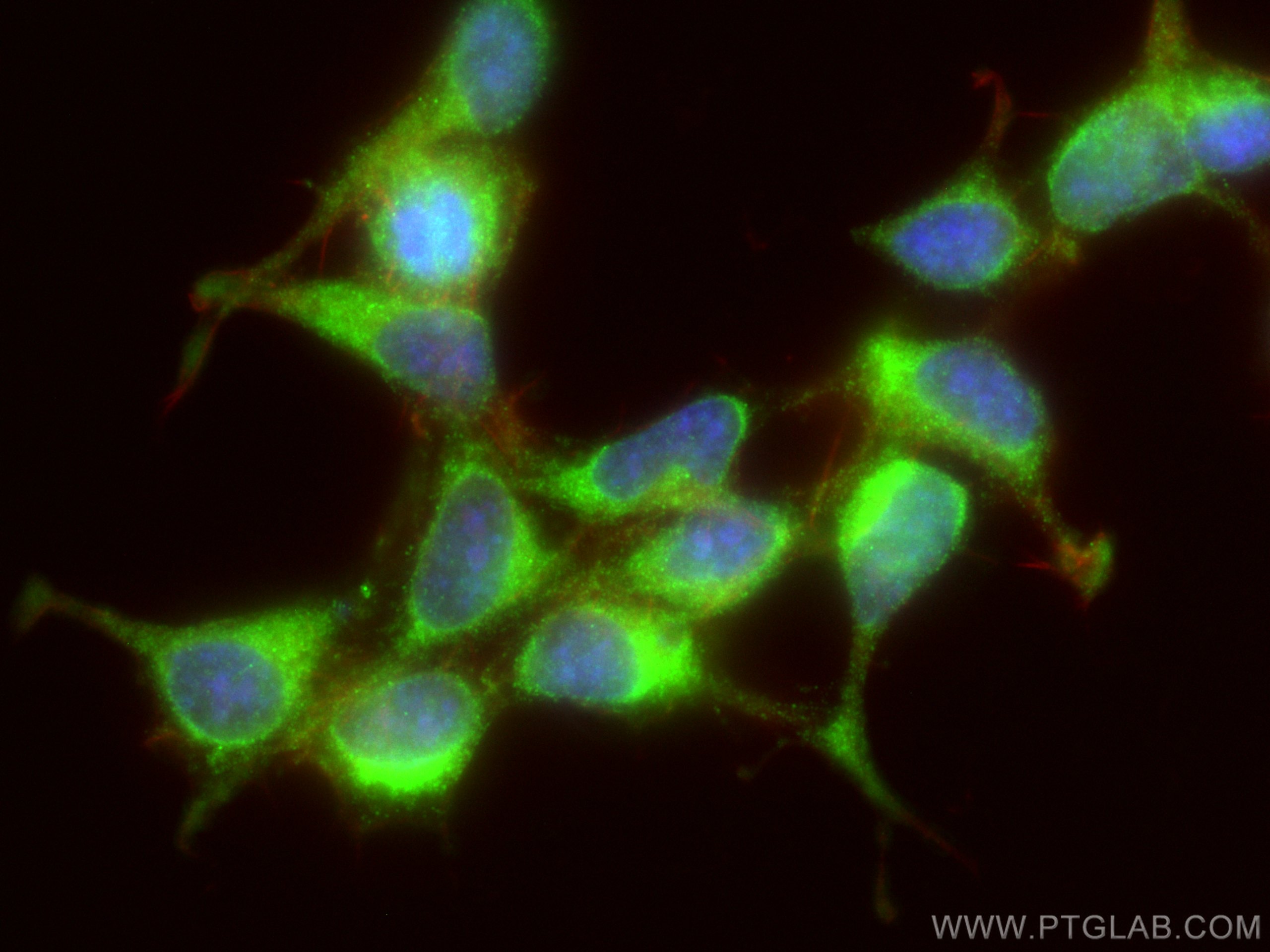- Featured Product
- KD/KO Validated
ATG16L1 Polyklonaler Antikörper
ATG16L1 Polyklonal Antikörper für WB, IHC, IF/ICC, ELISA
Wirt / Isotyp
Kaninchen / IgG
Getestete Reaktivität
human, Maus, Ratte
Anwendung
WB, IHC, IF/ICC, ELISA
Konjugation
Unkonjugiert
Kat-Nr. : 29445-1-AP
Synonyme
Geprüfte Anwendungen
| Erfolgreiche Detektion in WB | COLO 320-Zellen, HEK-293-Zellen, HepG2-Zellen, MCF-7-Zellen |
| Erfolgreiche Detektion in IHC | humanes Kolonkarzinomgewebe Hinweis: Antigendemaskierung mit TE-Puffer pH 9,0 empfohlen. (*) Wahlweise kann die Antigendemaskierung auch mit Citratpuffer pH 6,0 erfolgen. |
| Erfolgreiche Detektion in IF/ICC | HEK-293-Zellen |
Empfohlene Verdünnung
| Anwendung | Verdünnung |
|---|---|
| Western Blot (WB) | WB : 1:1000-1:8000 |
| Immunhistochemie (IHC) | IHC : 1:200-1:800 |
| Immunfluoreszenz (IF)/ICC | IF/ICC : 1:50-1:500 |
| It is recommended that this reagent should be titrated in each testing system to obtain optimal results. | |
| Sample-dependent, check data in validation data gallery | |
Veröffentlichte Anwendungen
| WB | See 7 publications below |
| IHC | See 2 publications below |
| IF | See 2 publications below |
Produktinformation
29445-1-AP bindet in WB, IHC, IF/ICC, ELISA ATG16L1 und zeigt Reaktivität mit human, Maus, Ratten
| Getestete Reaktivität | human, Maus, Ratte |
| In Publikationen genannte Reaktivität | human, Maus |
| Wirt / Isotyp | Kaninchen / IgG |
| Klonalität | Polyklonal |
| Typ | Antikörper |
| Immunogen | ATG16L1 fusion protein Ag31318 |
| Vollständiger Name | ATG16 autophagy related 16-like 1 (S. cerevisiae) |
| Berechnetes Molekulargewicht | 607 aa, 68 kDa |
| Beobachtetes Molekulargewicht | 68-75 kDa |
| GenBank-Zugangsnummer | BC000061 |
| Gene symbol | ATG16L1 |
| Gene ID (NCBI) | 55054 |
| Konjugation | Unkonjugiert |
| Form | Liquid |
| Reinigungsmethode | Antigen-Affinitätsreinigung |
| Lagerungspuffer | PBS with 0.02% sodium azide and 50% glycerol |
| Lagerungsbedingungen | Bei -20°C lagern. Nach dem Versand ein Jahr lang stabil Aliquotieren ist bei -20oC Lagerung nicht notwendig. 20ul Größen enthalten 0,1% BSA. |
Hintergrundinformationen
Human ATG16L1 is a 607 amino acid protein (~68 kDa) comprising three major domains: the N‐terminal ATG5 binding domain (ATG5‐BD), the central coiled‐coil domain (CCD) and a predicted C‐terminal WD40‐domain. ATG16L1α and β (Atg16L1α, 66 kDa; and Atg16L1β, 68 kDa) are the major isoforms expressed in intestinal epithelium and macrophages , and all isoforms encode exon 9, which contains Thr 300. Atg16L1 mediates the cellular degradative process of autophagy and is considered a critical regulator of inflammation based on its genetic association with inflammatory bowel disease. ATG16L1 has been implicated in Crohn's disease. (PMID: 24553140, PMID: 22740627,PMID: 28685931)
Protokolle
| PRODUKTSPEZIFISCHE PROTOKOLLE | |
|---|---|
| WB protocol for ATG16L1 antibody 29445-1-AP | Protokoll herunterladen |
| IHC protocol for ATG16L1 antibody 29445-1-AP | Protokoll herunterladenl |
| IF protocol for ATG16L1 antibody 29445-1-AP | Protokoll herunterladen |
| STANDARD-PROTOKOLLE | |
|---|---|
| Klicken Sie hier, um unsere Standardprotokolle anzuzeigen |
Publikationen
| Species | Application | Title |
|---|---|---|
J Nanobiotechnology Engineering exosomes derived from TNF-α preconditioned IPFP-MSCs enhance both yield and therapeutic efficacy for osteoarthritis | ||
Cell Signal Inhibition of XIST restrains paclitaxel resistance in breast cancer cells by targeting hsa-let-7d-5p/ATG16L1 through regulation of autophagy | ||
Food Funct EPA and DHA differentially coordinate the crosstalk between host and gut microbiota and block DSS-induced colitis in mice by a reinforced colonic mucus barrier. | ||
Anticancer Drugs Purvalanol A induces apoptosis and reverses cisplatin resistance in ovarian cancer | ||
Autophagy Regulation of N-Degron Recognin-Mediated Autophagy by the sars-cov-2 plpro ubiquitin deconjugase | ||
J Cell Mol Med CTSL Promotes Autophagy in Laryngeal Cancer Through the IL6-JAK-STAT3 Signalling Pathway |
Rezensionen
The reviews below have been submitted by verified Proteintech customers who received an incentive for providing their feedback.
FH Boel (Verified Customer) (07-30-2025) | 25µg gastrocnemius muscle total protein extract from mdx mouse (dystrophin deficient mice that are used as a model for Duchenne muscular dystrophy) generated a strong band of full lenght protein plus multiple additional bands of lower molecular weight. 25µg of total protein extract from pooled wild type zebrafish 5 days post fertilization generated no protein bands.
 |
